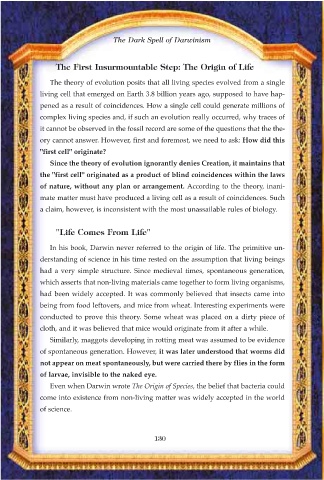Page 132 - The Dark Spell of Darwinism
P. 132
The Dark Spell of Darwinism
The First Insurmountable Step: The Origin of Life
The theory of evolution posits that all living species evolved from a single
living cell that emerged on Earth 3.8 billion years ago, supposed to have hap-
pened as a result of coincidences. How a single cell could generate millions of
complex living species and, if such an evolution really occurred, why traces of
it cannot be observed in the fossil record are some of the questions that the the-
ory cannot answer. However, first and foremost, we need to ask: How did this
"first cell" originate?
Since the theory of evolution ignorantly denies Creation, it maintains that
the "first cell" originated as a product of blind coincidences within the laws
of nature, without any plan or arrangement. According to the theory, inani-
mate matter must have produced a living cell as a result of coincidences. Such
a claim, however, is inconsistent with the most unassailable rules of biology.
"Life Comes From Life"
In his book, Darwin never referred to the origin of life. The primitive un-
derstanding of science in his time rested on the assumption that living beings
had a very simple structure. Since medieval times, spontaneous generation,
which asserts that non-living materials came together to form living organisms,
had been widely accepted. It was commonly believed that insects came into
being from food leftovers, and mice from wheat. Interesting experiments were
conducted to prove this theory. Some wheat was placed on a dirty piece of
cloth, and it was believed that mice would originate from it after a while.
Similarly, maggots developing in rotting meat was assumed to be evidence
of spontaneous generation. However, it was later understood that worms did
not appear on meat spontaneously, but were carried there by flies in the form
of larvae, invisible to the naked eye.
Even when Darwin wrote The Origin of Species, the belief that bacteria could
come into existence from non-living matter was widely accepted in the world
of science.
130

